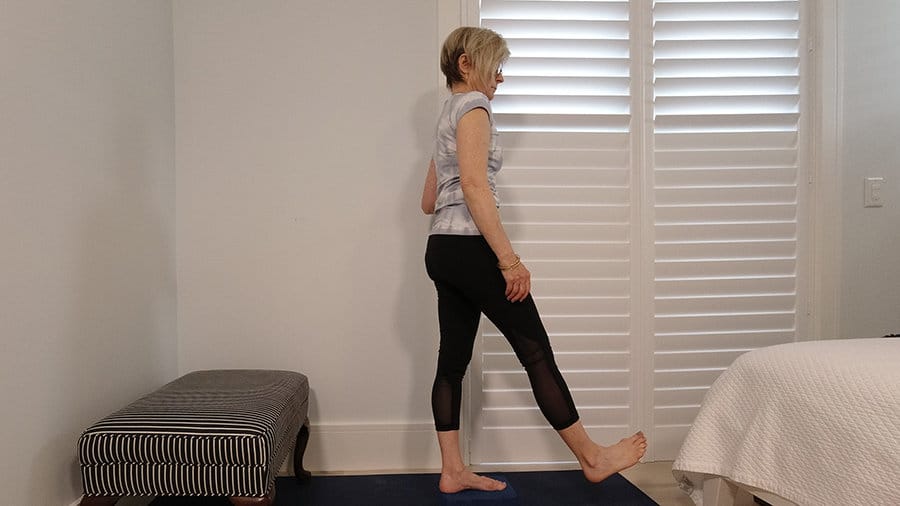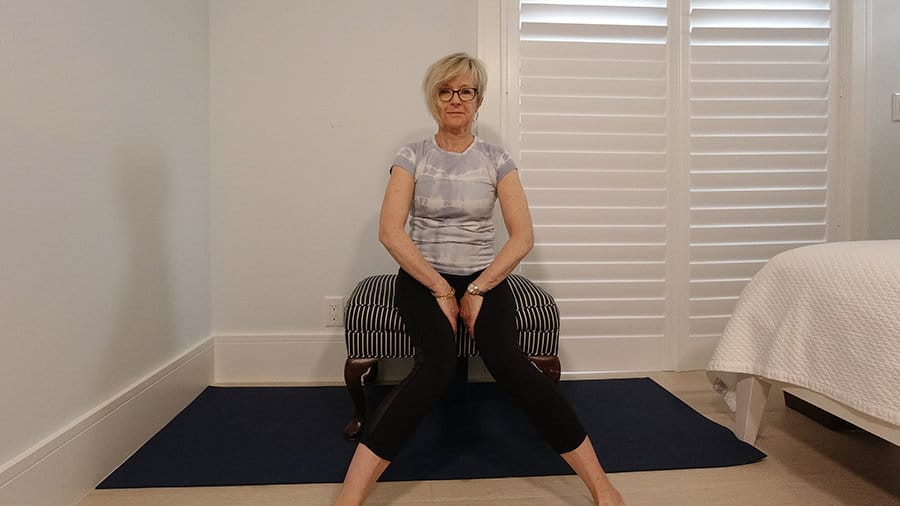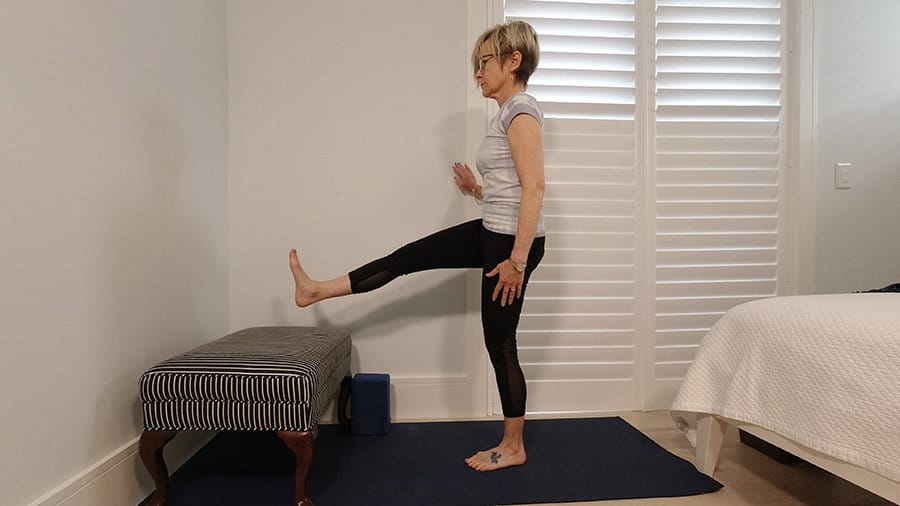Try These 7 Movements to Relieve Tightness in Your Hips without Passive Stretching
Tight hips are a common complaint among post-menopausal women. Hydration, sleep, and stretching are often recommended as helpers in the fight against tight hips.
I also believe that if we are going to alleviate chronically tight hips, we have to stop sitting so much and start moving more.
It’s All About Movement
When you experience muscle tightness, the solution is to work on increasing your mobility. Scientific advancements have revealed that the sensations we feel are not direct inputs from our muscles.
Rather, they are inputs from nervous system sensors on temperature, blood flow, inflammation, etc. The brain interprets this data and creates a feeling of tightness, pain, numbness, instability, ease, or something else.
Oftentimes, the sensation of tightness has a lot to do with your nervous system putting on the brakes and not allowing you to perform a certain action because it is an unfamiliar movement and your nervous system senses you do not have the muscle control or strength for the move.
A good example is hamstring tightness. If a person is unable to touch their hands to the floor (not a goal I suggest to my clients) in a forward fold because a tight sensation stops them, they assume that they need to “stretch” to change the situation.
What if I told you that your nervous system is accustomed to you sitting much of the day and knows you do not have the hip or hamstring strength for that move? That your healthy nervous system might put on the brakes and stop you from going too far?
But what if you gained strength in all the ranges of motion that your hips and legs can naturally accommodate? Would that make your body feel more comfortable with end range movements like a forward fold?
I have seen my clients gain a greater range of motion through strength and mobility work than years of stretching classes have done for them.
If you want to experiment with this, try all or a portion of these seven moves daily and see how you feel in a few weeks.
Also, if you would like an online consultation, contact Sarah for a Zoom video call.
Standing Psoas Release
Put your right foot on a block. Your heel needs to be solidly on the block so that you can make sure your weight is more in your heels. Make sure you have support nearby, like a wall, and use it for stability.

Swing your free leg forward and back without trying to use your hip flexors to move. Allow a bit of momentum to keep your leg swinging and your hip flexor on the swinging leg relaxed. Feel as if the weight of your leg is 100 pounds and it is being pulled toward the floor as it swings.
Switch legs.
Standing Hip Glide
Find a counter or table that reaches hip height. Hinge at your hips and place your hands on the table. From the hip hinge position move your hips from right to left with as little waist cinching as possible.

Move your hips a little bit to the right without a twist and hopefully you will feel sensations in your left inner thigh. Keep both legs straight as you do this. Then move to the other side. Go back and forth slowly. If you think you are going slow, move even a little bit slower.
Standing Hip Circles
Stand with your left side to the counter. With your left hand touching the counter for stability, bring your right knee up to hip height as if you were marching. Externally rotate the leg bone at the hip so that your knee is now pointing out to the right.
Now for the difficult part. Without using your low back muscles, internally rotate that very same leg, which will swing your lower leg out. With your mind’s eye at your knee, take that knee behind you as it sweeps back to its home base parallel to the left knee.
Complete this circle 3 times and then reverse the direction. Watch this video for an in-depth look at hip circles and how much they have helped my clients with SI joint or low back pain.
Windshield Wipers Redefined
Sit on a chair with your heels on the floor and placed wider than your hips. Your knees are probably out to the side in external rotation. Keeping your heels where they are, rotate the leg bones internally (your knees will move towards each other). Continue this internal and external rotation in a lazy fun way.

Shake that out. Starting back in external rotation again put your hands out the outside of your knees. Press your hands into your knees and your knees into your hands.
Feel that resistance and after lightening up on your hands create the internal rotation again with a focus on the resistance your hands can create going in both internal and external rotation. Think of this as a deliberate deep cleaning for your hip joints while also working your inner and outer thighs.

Leg Lifts
Stand with your left side to the counter. Your right leg is extended straight in front of you and the right heel is resting on a block. Hinge at your hips until you feel sensation in the back of your right leg.
Hold there and draw your right toes toward your face. Remember to breathe as you feel the sensations. Repeat 3 or 4 times.

Standing in neutral now with your weight in your left leg, lift your right heel off the block while keeping your torso still and your hips steady and neutral. Lift 5 to 7 times. Only lift as high as you can go without your hips, spine or shoulders shifting. It may be that you barely lift off the block and that is fine.

Repeat on the other side.
Squat
Position your legs wider than your hips with your legs hip distance apart. Take a little squat with your rear traveling behind you. Look down at your knees and notice where they are.
Come back up and this time make sure your hips are travelling behind you and your knees do not migrate towards each other. If your knees come forward a bit it is not a big deal, but do not let your knees collapse in.

As you squat, imagine you have racing stripes on your pant legs and push into the racing stripes to keep from collapsing in.
We will take 8 slow squats counting to 4 to go down and counting to 4 to come up. Resist the down using your glute muscles as brakes. Press through your heels and use your glute muscles as elevators.
Iliacus Release
Prop your hips up on a block, bolster, or a few firm pillows. Your feet will be placed on the ground about hip distance apart. Your pubic bone is higher than your hip bones and they are both higher than your waist.

Begin to breathe slowly. Imagine that the whole front of your legs and hips are relaxing and letting go. The muscles are just sliding down off the bolster toward your navel. Continue to breathe as you see in your mind’s eye that your hip flexors are relaxing into your body. Stay here as long as you like.
Everyday Movement
There is a sweet middle road where we can strengthen and lengthen our muscles to create more ease in our bodies. Short and tight muscles are essentially weak muscles. Oftentimes, that weakness is related to the fact that you do not give your muscles experience in a variety and diversity of positions on a daily basis.
The movements above are a nice routine to add variety and diversity while bringing an element of strength to your muscles. I always tell people that change needs to be easy to fit into your routines or the chances of success are low. So, start small.
Maybe choose only one of the ideas here and try doing it at the same time every day. Tack it onto something you already do every day, like making your coffee.
If you would like an online assessment or lesson, contact Sarah for a Zoom video call.
What is your range of motion at the hips? Do you feel tightness that brings unease in your movements? What do you do to interrupt your sitting time? Which of the movements shared above looks like something you’d be able to start doing right away? Please share with our community.
Tags Fitness Over 60






